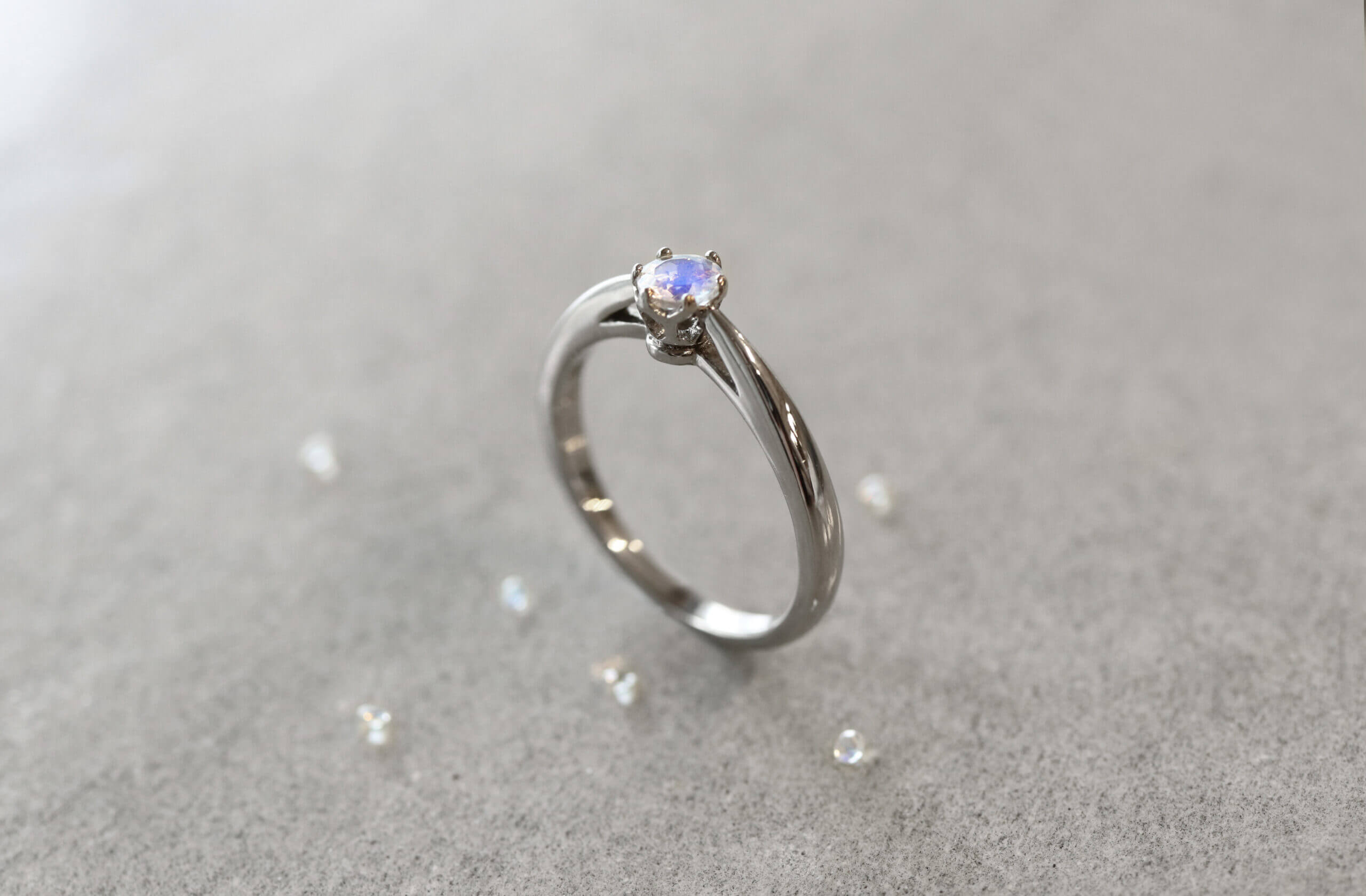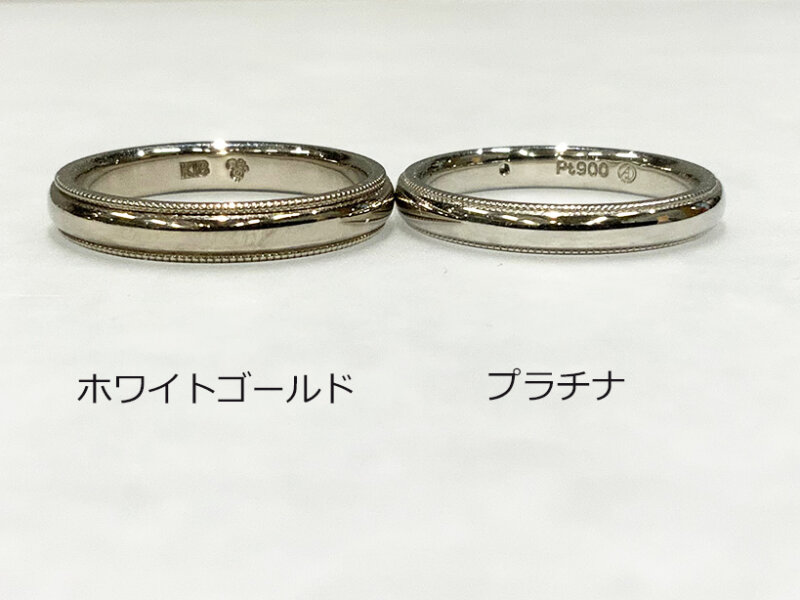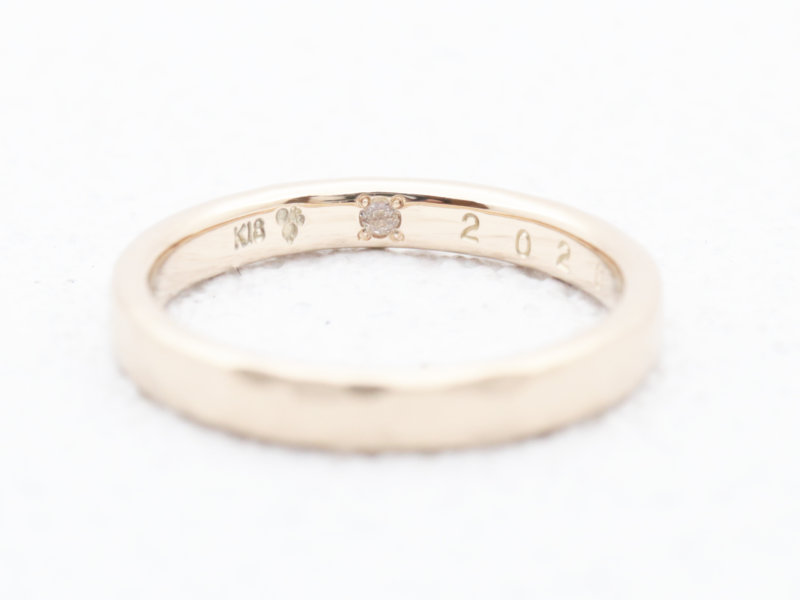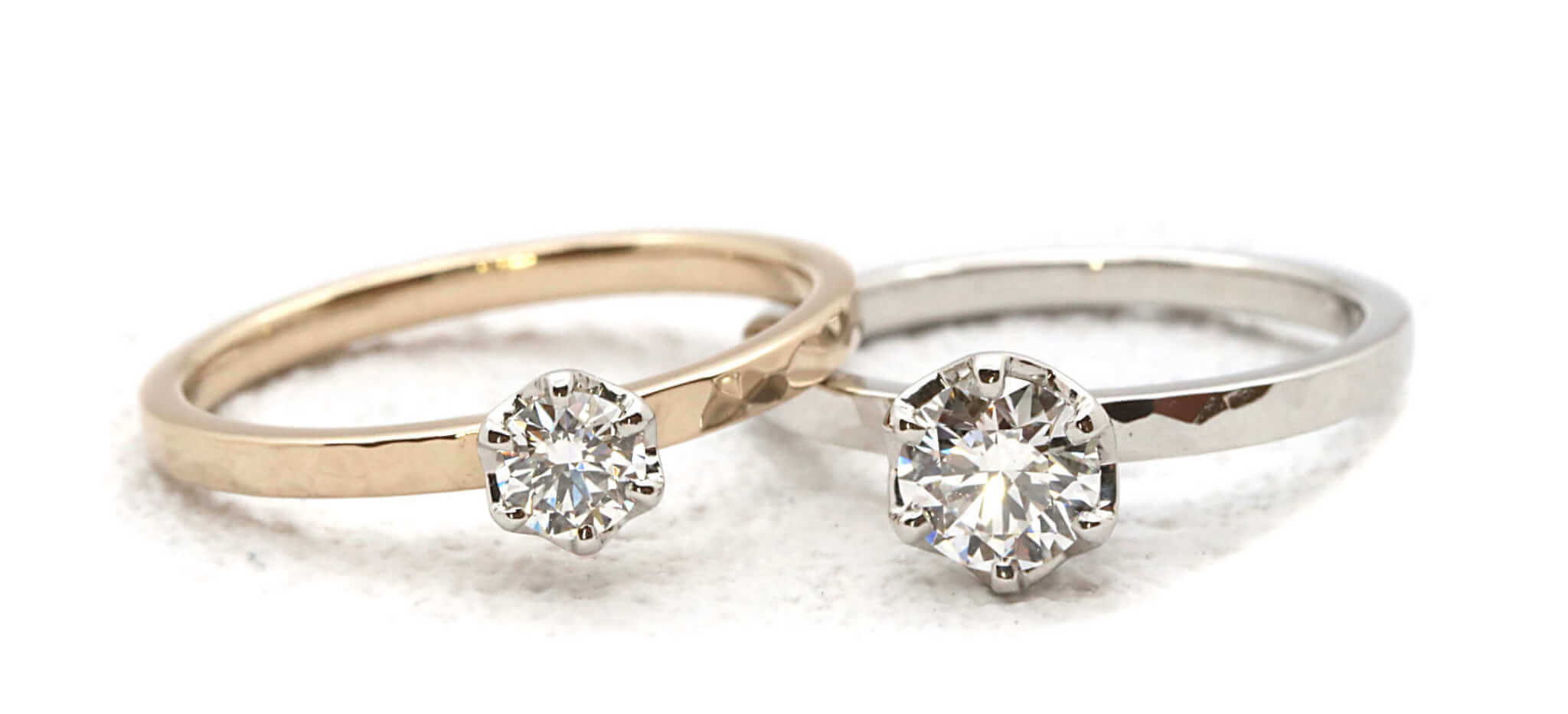In this issue, I would like to talk about moonstone.
Along with pearls and alexandrite, it is the birthstone of June.
The Mohs hardness is 6.0 to 6.5, and the cleavage is in two directions, making the stone a little soft.
Is "moonstone" a trade name? There is a separate mineral name.
The term moonstone is actually a trade name. The mineral name for the gemstone known as moonstone is feldspar.
Other typical feldspars (felspar) include sunstone, amazonite, and andesine.
The feldspar (felspar) group minerals make up more than half of the Earth's crust.
Belonging to the feldspar (felspar) group, it emits an adularescence (blue flash) when viewed in the light. It is also commonly referred to as the "shiller effect." Today, moonstone is basically the general term for monochromatic stones that have a unique bluish-white reflection.
It is characterized by a mysterious glow like the moon reflected on the surface of water.
This silirror effect is said to be created by the complex internal reflection of light captured by the multi-layered crystalline structure unique to feldspar.
To take advantage of this characteristic brilliance, moonstones are often cut into cabochon cuts, which are smooth and dome-shaped, but in recent years, faceted cuts have also been attracting attention.
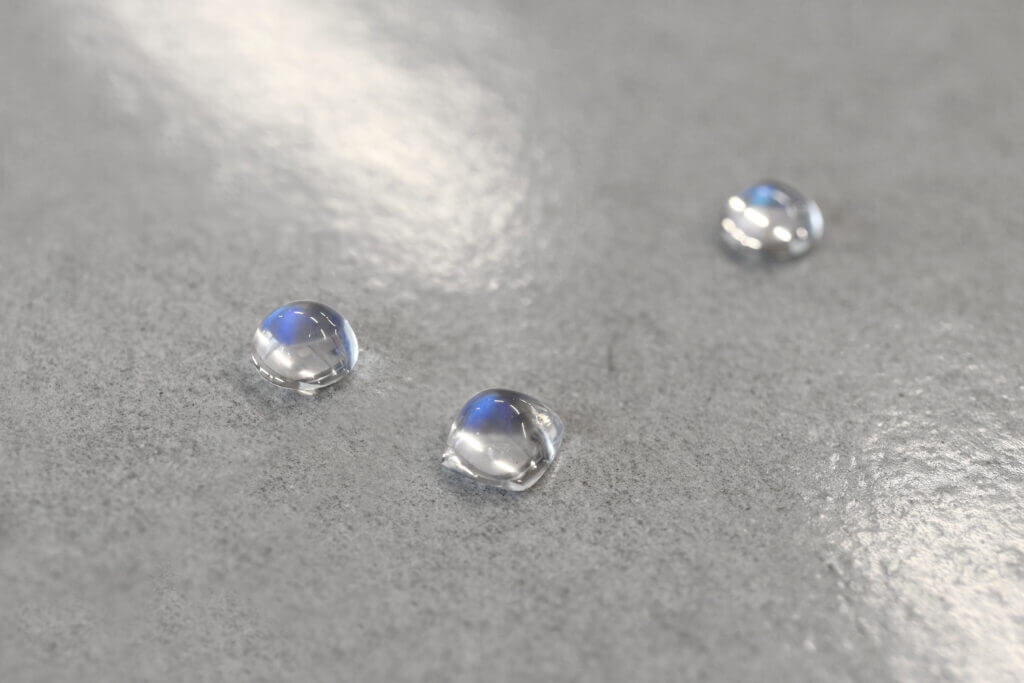
The color is generally milky white to translucent, but some are orange or yellow in color.
The short version is that the monochromatic stones with a shimmer effect within the larger group of feldspars are collectively called moonstones.
History of Moonstone
Gemstones called moonstones seem to have existed in ancient Greece and Rome, but we do not know if they are the same as the gemstones we now call moonstones.
Even in ancient India, moonstone was treated as a special gemstone. Moonstone was thought to be the crystallization of moonlight gathered from the moon, and was treasured as a talisman that contained the power of the moon.
René Lalique, a famous artist of the Art Nouveau movement that was popular in Europe from the late 19th to the early 20th century, also liked to use moonstone.
René Lalique is known as a French jewelry designer and glass craftsman. In his early years as a jewelry designer, he designed Art Nouveau style pieces, which later changed to the Art Deco style popular in Europe and mainly in the United States. Moonstone pieces can be found in the designs of the Art Nouveau style.
Art Nouveau is an artistic activity that focuses on natural and precise designs made by hand and not by industrial production. René Lalique also created many works with motifs of plants, insects, and birds. Moonstone can be seen in the motif of a dragonfly and a woman in the piece "Dragonfly Spirit. Moonstone was also used in a peacock brooch. This work can be seen at the Gulbenkian Museum in Portugal.Museum WebsiteBut I could watch it! (https://gulbenkian.pt/) Many of René Lalique's works can be seen at the Lalique Museum in Hakone.
Milky white moonstone orthoclase
The term "moonstone" is now used to refer to a wide variety of stones, so I would like to talk a little about the milky white to translucent stones that tend to be more commonly seen.
The white milky moonstone has the mineral name "orthoclase.
Syrah is characterized by a gentle light emanating from within the white color.
This "orthoclase" can be colorless to white, gray, green, pink, brown, and other variants of different colors depending on the conditions at the mining site.
Stones that are translucent and emit a strong blue shimmer effect are commonly known as "blue moonstones. It is characterized by an illusory glow that resembles the wings of a Morpho butterfly. Neither the moonstone nor the morpho butterfly is itself blue, but the reflection of light makes it appear blue. This is called structural color.
Labradorite and peristerite, gemstones called blue moonstone
Blue Moonstone is now a generic name for several stone trade names.
The two mineral names for blue moonstone that are commonly used today are "labradorite" and "peristerite.
Labradorite and peristerite also belong to the feldspar group. MITUBACI uses peristerite.
The stone that was first called blue moonstone is a variant of "orthoclase," which is technically a different stone, but the mine in Sri Lanka where this stone was said to have been mined is now closed and unfortunately cannot be extracted.
Therefore, the feldspar group, which is translucent and emits a strong blue shimmer effect, is now collectively referred to as "blue moonstones.
Labradorite" is a stone characterized by a strong silhouette called "labradorescence" (labradorite rays), which was discovered on the Labrador Peninsula in Canada in the late 18th century. The name "Labradorite" is said to have been named after the place of discovery.
Some labradorite is a white stone that glows in rainbow colors when held up to the light. This is called white labradorite and is often sold in stores as "rainbow moonstone. Unlike orthoclase, labradorite has a blue shimmer effect with yellow, green, and red reflections mixed in. The stone also often contains fibrous inclusions.
Peristerite" is characterized by a strong sheen called "peristerism. In terms of the chemical composition of its components, it is closer to labradorite than to orthoclase. In appearance, there is almost no difference between it and transparent orthoclase, and it is impossible to determine the difference by appearance. It is so difficult to tell without sending it to a specialized institution for analysis.
Moonstone's companion, felspar gemstones
I mentioned above that feldspar (felspar) group minerals make up more than half of the Earth's crust, and because of their abundance, felspar series stones come in a wide variety of colors and characteristics.
My favorite stone among them will be a red gemstone called "andesine".
Andesine is a relatively new gemstone discovered in the Democratic Republic of Congo in 2002. There are several countries that produce andesine, but those from Tibet tend to be rarer and more valuable due to their red coloration.
Andesine can be monochromatic, but some of them have a green color with a green color play effect.
The bicolor, which smoothly changes its expression from reddish brown to green, has an eye-catching appeal.
Also, perhaps because they are stones of the same felspar group, andesine's transparency has a beauty somewhat similar to that of moonstone, and I am strongly drawn to it.
Another red-colored member of the family is "sunstone.
The sunstone has oligoglaze and hematite as opaque chipped inclusions, which make it a fascinating stone to see the sparkling reflections through the clear fessloper stone.
It is interesting that although they are the same felspar type ore, one is named after the "moon" and the other after the "sun" due to slight changes in conditions in nature. Personally, during the month of June, Japan's moist rainy season, I feel like wearing moonstone, which is also the birthstone of June. In summer, the season of the sun, I want to coordinate my jewelry with sparkling and gorgeous sunstone jewelry as the star of the show.
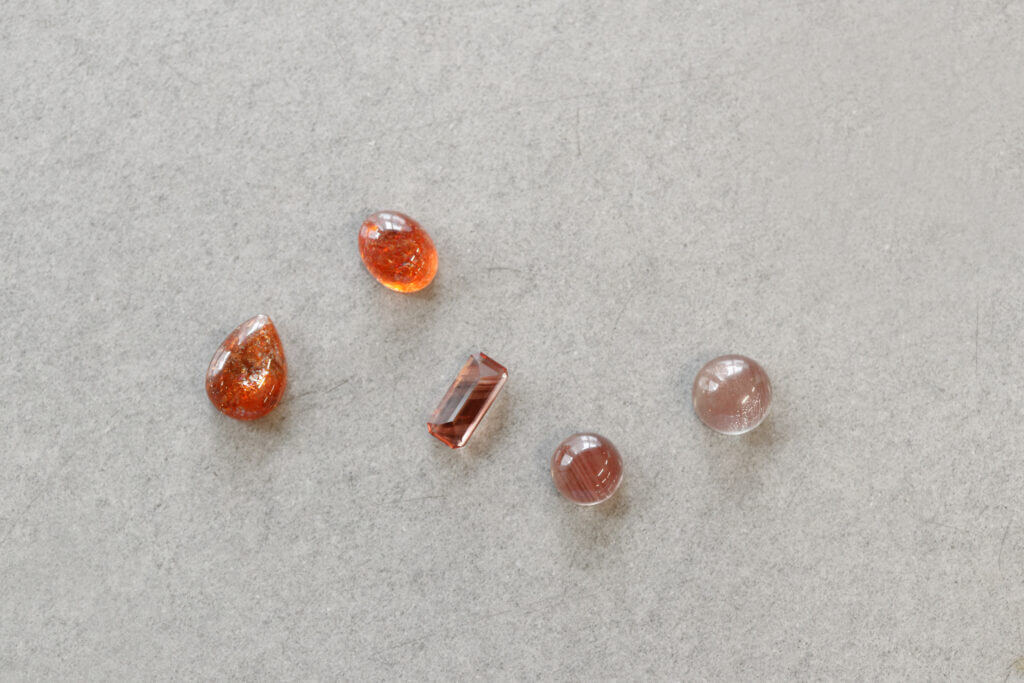
Moonstone, a gemstone that shines attractively
Depending on the way the light hits it, moonstone has a watery transparency, while at the same time it has a unique shimmering effect called the "shimmer effect," which is different from other stones with strong colors. We carry this beautiful gemstone at MITUBACI, so if you are interested in it, please ask our staff!
